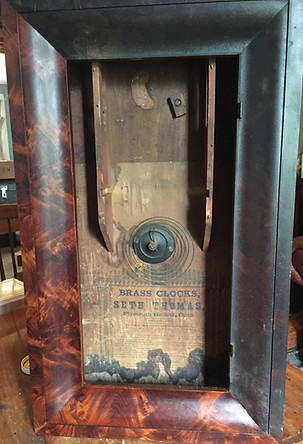
Restoration Services
With over a decade of experience in timepiece conservation, I specialize in early-American wooden movement tall case and shelf clocks. With a personal collection of dozens of original 200-year old mechanisms, I have fabricated machinery and tools to reproduce precision parts for repair work.
.jpg)
.jpg)
Most of the tools on my bench are hand crafted exact replications of early-American clockmaker's tools, like this copy of clockmaker Daniel Burnap's gear cutting engine. My other tools include original functioning period pieces, like my 18th-century jewelers bench vice, depthing tools, clamps, braces, compasses and other measuring calipers.
Below: An 18th-century jewelers or clockmakers bench vice, with Plymouth Connecticut provenance.
.jpg)
Above: A variety of antique and reproduction clockmakers tools. Reproduction tools are crafted by myself on my forge, and are exact replications of existing period artifacts.
.jpg)
.jpg)
.jpg)
Above Left: An original clockmaker's beam compass ca. 1800
Above Right: A reproduction staking anvil with my signature stamp
Wooden Movement Clocks
Wooden clocks are my specialty.
As a luthier's apprentice, I found significant joy in working with wooden instruments like the violin. With my interest in clocks, I found that the knowledge of ancient wood repair is transferrable to clocks.
With a collection of several dozen early tall clock movements, I have little difficulty professionally repairing original parts, or reproducing precision replacement parts. I always take precise measurements from original parts. Clocks in my private collection are essential assets when it comes to replacing parts that may be missing on a client's clock.

Clock by Elias Roberts, Bristol CT. Ca. 1805
My charging rates for services are affordable, for superior work compared to any competitors. As I specialize in strictly wooden clocks, my experience in this field outweighs the experience of the "local handy man" who services all clocks. Wooden clocks in my workshop are treated as artwork. My repairs are functioning, nearly invisible, non-invasive, and reversible if ever needed.
Reproduction Clocks and Parts
Very few clock repairmen can claim the title of being an actual clockmaker. Using period tools, techniques and traditions, I reproduce high quality reproduction timepieces and parts. These parts include mechanism parts, wooden parts, and even reverse glass painted tablets for clock case doors.
Right: An exact replica of Joseph Ives' first wagon spring steeple clock. Every single part of this timepiece was crafted by myself with period and reproduction tools.
Below: This Ives mirror clock, Ca. 1820 was just the back board and sides when I acquired it last spring. The entire veneered door, fluted columns, consoles, scroll work, dial, hands, reverse glass paintings, hinges, mirror, and other parts are all examples of my work.


Below: I made this brass movement clock in January of 2021. It is a copy of a Richard Manning wall clock ca. 1740 from Ipswich Mass. Every single part of this timepiece and dial, down to the rivets were hand crafted by myself. The corner motifs and single hour hand are cast in pewter using traditional sand casting methods. The gears are cut on my reproduction hand powered gear cutting engine.

Clock Case Conservation


With a background in woodworking, and training in finish work, I pride myself in my ability to restore the original appearance of early-American timepieces.
When understanding how organic natural finishes [the finishes originally applied], I have the ability to save, and conserve the original finishes when possible. My finishing process uses heat, and/or organic liquid solution techniques to save whatever original finish may be hiding underneath. With coordination with a client's request, I can restore a clock case to however the client wants. All of my finish work both makes the cases look new, while also maintaining its old-style look!
Brass Clocks
Weight-driven brass clocks are some of my favorites!
These weight-driven movements are commonly found in OG or experimental empire style cases made at the Bristol Connecticut area, and are made before the 1860s.
I have a trained background in properly restoring and conserving brass mechanisms. This includes the ability to re-bush worn bushings, straighten and polish pivots, arbors, etc.
Under no circumstance are my repairs insufficiently done with solder or other wasteful processes. Like wooden clocks, my repairs are non-invasive, functional, and reversible if needed.

.jpg)
.jpg)
The above mechanism was made around 1845 for a triple decker Ives patent roller-pinion movement. A previous "repair" individual horridly soldiered the roller pinions in place, almost a death sentence for this rare mechanism. Through a tedious and time consuming process, all of the solder was properly removed from inside the pinion bushings. The main bushings were also re done in a non-invasive, nearly invisible manner.
Spring Clocks
My interests, training/background, and abilities towards antique clock restoration and conservation is limited to weight driven clocks. Because of my limited abilities in other fields, I am able to flourish in the specialty work I do in wooden and weight-driven brass clocks.
Because of this, I will not work on spring clocks.
I am not trained in spring clocks the way I am in wooden and weight-brass clocks. You wouldn't go to a neuro-surgeon to fill a cavity in your teeth, so please do not contact me in regards to common spring clocks. I specialize in wooden and weight-brass clocks because those are what I am trained and experienced in.